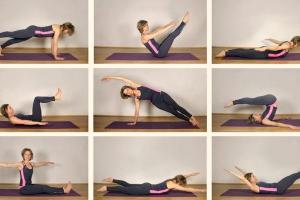Pilates for beginners at home is the best set of physical exercises that help improve the health and spiritual background of a person. The founder of this training system was Josef Hubertus Pilates from Germany, who suffered from asthma, rheumatism and rickets in childhood. By the age of 20, the young man had already completely transformed his body and strengthened his body, designed many simulators and created several gymnastic exercises that are basic in many sports: gymnastics, bodybuilding and yoga.
What is Pilates?
Many consider it traditional fitness, stretching or breathing practices. In fact, Pilates is a unique training system and the best set of exercises for beginners performed by a person:
- at home or in the gym;
- any age and gender;
- without special requirements for the level of physical fitness;
- with a minimum possibility of injury;
- during pregnancy and during lactation.
To perform a series of exercises, you do not need to look for a trainer, as Pilates lessons for beginners at home are freely available on video or described in articles on the Internet.
Developed in the 20s of the last century, the technique went around the whole world in a swift wave and the Americans initially took a closer look. Only in the middle of the twentieth century, the system was included in the programs of the world's leading fitness clubs and some medical and health institutions, with a set of preventive training after injuries of the musculoskeletal system.

A set of exercises at home
Today Pilates is a system of movements harmoniously uniting the mind, body and spirit.
Pilates, as a separate type of physical activity, has its own principles, rules and procedures:
- smooth movements, without jerks and powerful loads;
- isolation and relaxation, without tension of unused parts of the body;
- breath circulation - inhalation is through the nose, and exhalation through the mouth;
- focus on the correct execution of movements and personal sensations;
- centering - stretching the abdominal muscles and tensing them for a short period of time;
- gradual increase in loads;
- accuracy of body symmetry - the pelvis, shoulder blades and shoulders should be on the same line
control - muscle control; - regularity - performing techniques 2-3 times a week.
The main goal of training is elastic and strong muscles, and their philosophy is the ability to control your own body.
The benefits of classes

Regular Pilates improves posture and strengthens muscles.
With regular exercises, the strength of the whole body increases, posture improves, muscles become stronger, and balance and coordination of movements improve.
In 10 minutes of Pilates for beginners at home, there is a noticeable stretching of the spine, the stomach becomes flatter, the neckline is taut, and the trainee feels lighter and freer than before the workout.
Doing a course of regular Pilates lessons today has a number of benefits in the near future:
- lack of discomfort in the spine and lower back;
- a slim body;
- elastic muscles, flat stomach and strong posture;
- healthy internal organs of the digestive, cardiovascular and respiratory systems;
- tightened hips;
- healthy sleep and lack of depression;
- mobile joints;
- stabilized blood circulation;
- active lifestyle and a large supply of positive energy.

Pilates for beginners at home is effective for weight loss
The main technique of these workouts is to perform them with special attention to the correct breathing technique and control of the abdominal muscles. Only in this way will the benefits of training be as effective as possible.
Pilates for beginners at home is effective for weight loss, as an additional exercise to more intense sports. It contributes to the strengthening of muscle tissue and harmony, but does not burn body fat as quickly as power loads, aerobics, running and more can handle it.
The best workout for fast and healthy weight loss is a 50-minute intense workout starting with cardio and alternating with Pilates exercises.
Contraindications for Pilates

Pilates is good for older people too. However, a doctor's consultation is required.
The set of exercises is intended for a wide range of people, but it is not recommended by doctors and Pilates instructors for people:
- with severe varicose veins;
- with fever;
- with the presence of thrombosis;
- with inflamed areas (after injury);
- in the last stages of pregnancy.
Pilates for beginners at home is good for older people. But before you start training, it is recommended to consult a doctor.
Rules for Beginners

Pilates for beginners at home
Those wishing to join the physical culture of Pilates must initially know what it is and what its benefits are. People who are well-read on this topic and “get acquainted with it” from the words of friends are not yet beginner Pilates trainees. In order for the exercises performed independently, at home, to be beneficial and effective from the first workout, you need to listen to the following tips:
- choose a program strictly individually, in accordance with your level of physical fitness;
- work with your own weight, do not rush to take on weights and special simulators;
- watch video lessons in your native language;
- be collected and concentrated;
- know that quality is more important than quantity here;
- listen to yourself, be honest with yourself;
- in case of fatigue, take a "short break";
- remember that these are low-impact, low-intensity workouts.
Now, knowing the "moral" of Pilates and in order to start doing Pilates exercises at home for beginners, you only need a desire and a soft fitness mat.

Pilates exercises for beginners: you need desire and a soft mat
All reviews about the effectiveness or benefits of Pilates are divided into positive and negative. The last of them is the opinion of people who have begun to perform workouts that do not correspond to their physical fitness or state of health, and also do not know how to “listen to their body”! Statistics show that there are much more positive feedback from the results of classes! It is only important to understand the specifics and regularly perform the exercises.
Exercises
All exercises should be smooth, without sudden movements. Pain is not about Pilates. If there are sharp discomfort - stop the task and move on to the next one.
"Warm-up"

Exercise - warm-up
Before you start exercising, you must thoroughly stretch all the muscles.
In Pilates, the warm-up is considered to be "tuning" the breath. It is necessary to breathe through the chest, inhale a large amount of air through the nose and exhale completely through the mouth. You need to breathe calmly, expanding the ribs when inhaling and reducing them to the center - when exhaling.
Warming up increases the heart rate and raises body temperature by 1-2 degrees. The warm-up time is at least 4 minutes.
“Spin up and down”
In the process of performing the exercise, the muscles of the back, back of the thigh, and the cortex are involved and are performed in stages:
- put your feet shoulder-width apart, slightly bending at the knees,
- stand straight, lower your shoulders;
- raise your arms up while inhaling, and while exhaling, lower your torso down;
- twisting, stretch the crown of your head to the floor;
- inhale and slowly raise your torso up while exhaling;
- the position of the body should be in the “half-squat” position.
Return to starting position and repeat 5-6 times.
"Plank"

Exercise - plank
The standard version of the "bar" is performed as follows:
take an emphasis lying face down, leaning on your elbows and toes;
the body should form a straight line from the top of the head to the heels, do not bend with the hips;
hold for one or more minutes and breathe evenly the whole time.
When performing this trick, all the muscles of the body are “turned on”.
"Twisting lying with straightened arms"
“Turns on” the abdominal muscles and is performed as follows:
in the supine position, bend your knees and press your feet to the floor;
exhaling, lift the torso to the waist twisting in the spine;
linger for 1-3 seconds and exhaling, return to the starting point.
Repeat 10-12 times.
"A hundred"

Exercise - Hundred
A hundred here is the number of hand swings in a prone position with legs raised. To do it correctly, you need:
- lie on the floor and raise your head slightly;
- straighten your arms along the body and draw in the stomach;
- raise your legs together, at an angle of 40 degrees and stretch your socks;
- perform hand swings “up and down” - 6 hand movements on inhalation, 6 on exhalation.
"Tumbler on the back"
It is rolling on the floor on the back from side to side, exhaling when turning to the right, inhaling - to the left. Ideal for coordination of movements.
"Tumbler in a sitting position"

If you want to become the owner of a slender, toned body and prefer fairly calm static exercises, then you should get acquainted with the Pilates system.
Unfortunately, many people do not have enough time for regular visits to the gym. Therefore, sets of exercises that can be done at home without the use of sports equipment are very relevant. If you want to become the owner of a slender, toned body and prefer fairly calm static exercises, then you should get acquainted with the Pilates system.
Piletes system: a bit of history
Developed by Joseph Pilates. Joseph was born at the end of the 19th century in Germany. Since childhood, he was very weak: the boy suffered from asthma, regularly suffered from infectious diseases. However, thanks to his perseverance and conscious attitude towards his own body, Pilates managed to overcome all ailments. Already at the age of 14, he developed his own set of exercises, which helped Joseph not only get rid of diseases, but also gain an athletic physique.
In 1926, Pilates migrated to the USA. There, his system instantly gained immense popularity: men and women, businessmen and housewives, movie stars and show business figures were engaged in Pilates.
Advice!If you decide to exercise at home, make sure you wear comfortable clothing. It should not be too tight and impede movement. Loose shorts and a light T-shirt made of cotton fabric are perfect.
The main dogmas of Pilates
Like all other sets of exercises, the Pilates system involves a load on the muscles of a person. However, the uniqueness of the system lies in the fact that this load is not dynamic, but static. All exercises are performed very smoothly, so that the risk of injury is minimized. The main goal of the exercises is to learn to feel every muscle in your body and control it.
Another pillar of the Pilates system is proper breathing. During the execution of the complex, it is necessary to carefully monitor each inhalation and exhalation, otherwise the system will not bring any result.
Mindfulness is also important: you need to fully focus on your own feelings and control every muscle that is involved during the exercise.
Finally, you need to exercise regularly, at least three times a week. Only in this way will it be possible to strengthen the muscular frame and create the body of your dreams.

Who should do Pilates?
Classes are recommended for people who have never played sports before. Pilates is especially indicated for those who have any contraindications to intense exercise. In particular, the system can be used by people with diseased joints.
Both young and old people can train. In the absence of medical contraindications, even pregnant women can perform exercises.
Advice! Well ventilate the room in which you are going to exercise.
System Benefits
The main advantages of the Pilates system include the following:
- you can practice at home at any time convenient for you;
- the system has practically no contraindications;
- the lesson will take from 20 to 40 minutes, which is very important for busy people;
- during exercises, you will get the opportunity to work out all the muscles, including deep ones;
- through exercises you can correct your posture;
- exercise speeds up metabolism;

- Pilates contributes to the development of flexibility: after a few months of training, many people who practice this system even manage to sit on a twine, which previously seemed almost impossible to them;
- The result will be noticeable after a couple of weeks of intensive training.
Advice! Avoid distractions while exercising: ask your family members not to disturb you and turn off your phone. Pilates requires total focus on your feelings!
The main disadvantages of the system
Of course, like any system, Pilates has some disadvantages. These include:
- the need to do exercises regularly, without missing classes and not postponing them for later. Unfortunately, not every person is distinguished by high self-discipline. However, if you practice only once a week, then you will not see the result for a very long time;
- exercise is not very effective for losing excess weight. Weight may even increase slightly due to the fact that muscle mass is growing;
- exercises must be performed in the right way: if you make a mistake, then the result from training will be zero;
- it is necessary to concentrate completely on the performance of each exercise: it is quite difficult to create conditions in which nothing distracts from the lesson.
Of course, these disadvantages are rather arbitrary, but they must be taken into account when choosing a system for homework.

Advice! During exercise, do not make sudden movements. You risk injury or sprains!
What do you need to practice at home?
In addition, it is worth buying a special fitness mat. Many of the exercises are done on the floor, so a mat will make the exercise more comfortable. You can find this mat at any sports equipment store.
Some exercises are performed with a hoop or fitball.
Finally, you will need a chair: you will lean on it during execution.
exercises.
Advice! If you do not have a special fitness mat, you can use regular travel foam.
Exercises for the abdomen
These exercises will help you get rid of fat deposits in the abdomen and become the owner of a strong, toned press:
- take the starting position: lie on your back, bend your knees and elbows. Raise your legs slightly, with your toes pointing forward. Take a deep breath, try to tighten your abdominal muscles as much as possible, and raise your legs at an angle of approximately 45 degrees. The arms should be extended along the body. Freeze in this position and count to 20. After that, relax, lie down on the floor and take a breath;

- lie on the floor, bend your knees. Place your feet shoulder-width apart. Raise your arms to the ceiling, lower them along the torso. You can’t put your hands on the floor: they must be on weight. Raise your head, while keeping your shoulders on the floor. Tighten your abs, take a deep breath. You should feel how your abdominal muscles work: if you do the exercises correctly, they will tremble and burn. Count to 20, take the starting position;
- this exercise was borrowed from yoga. Get on all fours. Move your pelvis forward, tilt your head and round your back. Freeze in this position for a few seconds, taking a deep breath. Try to tighten your abdominal muscles as much as possible. As you exhale, take the starting position;
- this exercise is called "Boat". Sit on the floor, bend your knees and grab your hips with your hands. Take a deep breath, raise your legs so that they are parallel to the floor, keep your hands parallel to the floor. Hold this position for 15-20 seconds. If it's too hard for you, you can shorten this time: hold on for as long as you can.
Advice! Work out barefoot or in thin socks. Sneakers are not required, on the contrary, they will interfere.
Hip Exercise
This exercise is effective for strengthening the hips, and also improves the mobility of the hip joints and helps get rid of cellulite.
Lie on your back. Place one leg on the mat, stretch the other up. Breathe in as deeply as you can. Feel the air enter your lungs. At the exit, lower the leg, which is extended upwards, towards the opposite knee. It is important that the knee is not bent, otherwise the exercise will not be effective enough. Lower your leg slowly enough. When your foot touches the floor, slowly return to the starting position. For each leg, the exercise is repeated at least 10 times, you can do several approaches.
Advice!Exercise can be done at least an hour after eating.
 With the help of such simple exercises, you can "discover" new muscles in yourself.
With the help of such simple exercises, you can "discover" new muscles in yourself. Back strengthening exercise
Lie on your stomach, touch your forehead to the floor. Hands should lie freely along the body. Exhale and lift your shoulders off the floor as high as you can. Hold this position for a couple of seconds and slowly lower your shoulders to the floor. You should feel how your back muscles work.
Advice! If you are not feeling well, please reschedule your session. Pilates involves a fairly high load, which the body weakened by the disease may not be able to withstand.
Hand exercises
Stand straight, put your feet shoulder-width apart. Raise your arms in front of you parallel to the floor. Turn your hands palms up, bring them behind your back as far as you can. Start making slow movements, trying to "connect" your hands behind your back. Hands throughout the exercise should remain parallel to the floor! Count to 20, take the starting position.

During this exercise, you will feel quite strong tension in the shoulder and forearm. This is completely normal: the muscles should start to “burn”. If you feel something like this, then you are doing everything right!
Advice! If you feel unwell during a class, such as feeling dizzy or having a buzzing in your mind, stop immediately! Relax, lie down, drink some water. As a rule, unpleasant sensations appear in beginners who have never played sports before. As a rule, after a while the body adapts to the loads. If this does not happen, you should consult a doctor.
A set of exercises to strengthen the legs
You will need a chair for this exercise. Stand near the back of a chair, grab it with your hand. Spread your toes out to the side like ballerinas do. Begin to squat slowly, trying to keep your knees apart. At the deepest point of the squat, lock in and count to 20.

Slowly return to starting position. The exercise is repeated from 5 to 10 times: it all depends on the level of your physical fitness. Advanced fans of the Pilates system do a “gun” during this exercise, that is, they keep one leg parallel to the floor.
Advice! Before starting home workouts, visit a few classes at the fitness center. A professional instructor will help you figure out how to do the exercises.
For several centuries, women and men around the world have attached great importance to their figure and appearance, improving, adding health, harmony and beauty to it.
Such perseverance and aspiration is noticeable in modern society. Pilates- a direction that helps to "blind" a figure from your dreams, while not requiring special material investments and supernatural physical exertion.
What is Pilates?
Pilates is an exceptional set of exercises aimed at working out all muscle groups to create a healthy and amazing body, for weight loss.
Pilates has absorbed completely different areas of physical culture, such as yoga, classical and modern choreography, acrobatics, martial arts, combining them and making them a single system.
Pilates develops flexibility and mobility of joints, strengthens muscles, makes them stronger, improves tone, corrects posture.
History of appearance
 This technique for improving the body was developed by Josef Hubert Pilates.
This technique for improving the body was developed by Josef Hubert Pilates.
Transferring knowledge and experience to his students, he joined the ranks of his admirers by opening his first training studio, and his system of exercises gained popularity around the world.
In his program, he taught correct breathing, stretching and wrestling, while using all kinds of equipment that he himself created. The "Pilates Method" has become famous not only among men and women, but also among children and the elderly.
At the moment, Pilates is one of the best programs that correct the figure and improve it. As practice and experience show, Pilates classes are most popular among women, however, they are equally suitable for men.
What are the benefits of Pilates?
For women
Josef described the gluteal muscles and the muscles of the abdomen and thighs as the "center of power", which is why most exercises are aimed at strengthening these areas. They, in turn, are in most cases the most problems in females.
This direction is suitable for owners of figures such as "pear", "hourglass" and "apple" - it will provide an opportunity to improve problem areas, remove fat.
Among other things, Pilates is useful for women over the age of forty. It prevents diseases affecting the skeletal system, increases muscle elasticity, calms the nervous system and fights emotional instability.
As a "nice bonus" Pilates classes for girls and women will be the study of the so-called intimate muscles. Some exercises affect the work of the muscles of the small pelvis, which helps to increase the sensitivity of the intimate area.
For men
 Pilates is good for men primarily because it helps improve overall fitness levels, develop even greater endurance and muscle activity.
Pilates is good for men primarily because it helps improve overall fitness levels, develop even greater endurance and muscle activity.
When playing sports, men are most often guided by the desire to build muscle mass as quickly as possible and therefore attach great importance to power loads.
At the same time, most of them forget about how important it is to increase flexibility and not clog muscles. After all, it is stretching and strengthening exercises that allow you to quickly restore muscles after strength training, increase blood flow, elasticity of ligaments, and avoid injuries.
Pilates will be useful for lovers of beer drinks, because with frequent use, excessive fat deposits appear in the abdomen. To get rid of it, the male half of the population begins to actively work on the press, completely forgetting about the muscles of the back and spine, and in fact they are primarily subjected to loads.
Uneven muscle training can lead to back pain. Pilatas, on the other hand, will allow you to evenly tone all muscle groups without much effort and have a fruitful effect.
Advantages and disadvantages
Principles of Pilates
The technique for organizing Pilates classes is as follows:

Indications for Pilates

Before starting your first workout for beginners, you should be familiar with the following principles of Pilates:
- breath concentration;
- accuracy and control of the technique of each movement;
- smoothness of execution;
- absolute relaxation and the absence of extraneous thoughts;
- regularity of classes;
- warming up the muscles
Duration and frequency of classes
As in any other business, the correct frequency of classes is important to achieve maximum results. When doing Pilates once a week, it will not be possible to achieve the desired result and improve your physical shape, because the muscles will not have the opportunity to get used to the loads.
For the desired result, you need to practice two to three times a week for one hour. As for the inventor himself - Joseph Pilates - he recommended 4-5 classes per week.
Can Pilates be practiced at home?
Doing Pilates at home is definitely possible and necessary. If your goal is to get visible results without cardinal physical exertion, overstrain and pain, then Pilates at home will be your salvation.
Compared to other methods, Pilates is superior to others in that it affects the entire body, and not just individual parts of it. The fashion for Pilates at home dictates an individual non-standard approach to training, without simulators and visits to the gym.
Simple Basic Exercises
Exercise "hundred" (hundred)

Exercise "twisting up"

Penknife exercise

Neck extension exercise
- The exercise forms posture and improves the mobility of the musculoskeletal system.
- While lying down, try to stretch your head and neck vertically upwards in a sitting position or standing, leaning forward.
- In this case, the chin should reach for the chest;
Exercise "stretching straight legs in turn"

Exercise "bud"
- In the supine position, it is necessary to bend the legs so that they become perpendicular to the surface of the body, and then reach your knees with your hands.
- Next, you need to simultaneously stretch your arms and legs forward at a 45 degree angle.
- In this position, you should remain for several seconds, and then return to the starting position. This exercise should be repeated in three sets of 10-15 times.
Complex exercises
Little Mermaid Exercise
- Strengthens the muscles of the press and abdomen, wrists and shoulder girdle.
- First you need to sit on the floor in the Turkish position and place your hands on your hips.
- As you straighten your spine, drop your shoulders down and lengthen your neck, looking forward.
- Having fixed the left leg in a fixed position, you need to straighten the right and leave it in front of you.
- Next, you should bring the limb behind the right buttock.
- Bending your right arm at the elbow, try to turn it with your palm up.
Exercise "lifting the legs up in the lying position"

Exercise "circles with legs in emphasis on the elbows"
- This exercise tones the abdominal and abs muscles.
- Sit on the floor and place your hands on the mat behind you.
- Fingers on the hands should be turned back.
- Next, you need to raise your legs so that the body looks like the letter "V".
- The weight of the entire body should be on the ischial bones.
- Exhaling, turn the pelvis and legs to one side, then return them to their original position with a circular motion.
Exercise "rolls on the stomach"

Can pregnant women do Pilates?
The fact that during pregnancy it is necessary to engage in specially designed gymnastics is not denied by any doctor.
Among the advantages are the following:

Can you lose weight with Pilates?
If you set a goal to lose weight, then it takes time to achieve it with the help of Pilates. During this sport, there is no rapid fat burning, but the effect will become noticeable after a cycle of regular training.
In the event that weight loss is an immediate desire, then it is worth combining Pilates with aerobics.
results
In the event that you plan to lose more than fifteen kilograms of excess weight, then Pilates is a great way. Slow, but extremely effective calorie-burning exercises will not only help you lose weight, but also improve your health.
With a small difference in time, compared to those who lose weight on an accelerated program, you will achieve the desired result and at the same time you will have a stronger healthy body.
In the future, continuing classes, it will be possible to maintain the acquired weight, of course, this is feasible only at the same time as proper nutrition. As a result, the result will exceed all expectations: the stomach will become flat, the muscles will get stronger and will be tightened, and poor health and a tired look will disappear forever.
Pilates for the press
Pilates for the press is an excellent rehabilitation training technique that will help get rid of problem areas. It will help develop absolutely all muscle groups and cope with fat deposits on the abdomen. With the help of Pilates, you can get an almost flawless waist.
Pilates for the hips and buttocks begins with a basic set of exercises that are aimed at building muscle strength and elasticity in the desired area:

Pilates stretch
Stretching, resistance exercises, all kinds of strength exercises and proper breathing technique will all increase the flexibility of the body when practicing Pilates. This sport is a kind of offshoot of yoga.
The cult of a beautiful and impeccable body in modern society has become very important. Going to the gym, proper nutrition, that is, what improves health and physical fitness, have become popular.
Everyone has the right to choose their own path of development to achieve the desired result. But, as usual, only those methods that have been used by other people for decades are credible. Pilates is one of those.
It will suit you if you:
- complain of recurrent pain in the spine;
- suffer from osteoarthritis;
- leave a sedentary lifestyle;
- want to strengthen your back muscles and improve their flexibility;
- Do you need to recover from an injury?
- Do you want to keep fit during pregnancy?
Pilates- This is a special type of gymnastics aimed at rehabilitation and strengthening of the spine, developing strength, strengthening muscles with maximum lengthening of the body. For the first time this system was developed by the German Joseph Hubert Pilates, thanks to which he himself overcame asthma, rheumatism and other diseases.
The main advantage of Pilates is that it is suitable for absolutely all ages, does not require serious sports training, and Pilates is convenient for beginners to practice at home.
You should love this type of fitness if you are looking for a non-aggressive form of simple but effective sports exercises.
But for those who want to achieve relief and gain weight, we still recommend paying attention to exercises aimed directly at the muscle group that needs to be worked out.
- , will help not only create a beautiful relief, but also make your hands slimmer;
- a new set of exercises will help;
- how to lose weight in 20 minutes a day read;
- , slimming and firmness.
Features of Pilates
Pilates is a smooth and unhurried gymnastics where breathing plays an important role.
What to do Pilates?
 Before you start, choose clothes that are comfortable and free for movement. It should be in a sticky, but not fetter the body.
Before you start, choose clothes that are comfortable and free for movement. It should be in a sticky, but not fetter the body.
It is better not to wear baggy T-shirts and T-shirts - you will need to control how correctly all elements of the movements are performed.
If the floor is warm, exercise barefoot or in socks. Shoes will only interfere with the participation of the feet and the warm-up. It is advisable to train on a sports soft mat, spacious enough and comfortable.
How to breathe correctly?
Breathing when doing Pilates at home is very important. Maintain a calm and rhythmic breathing, inhaling through the nostrils and exhaling through the mouth. Keep your stomach pulled in, inhale with your sternum, but without arching it with a wheel. The chest is straight on inhalations and when the arms are raised. Don't overstress your ribs. Fully inhale and exhale the air so that the lungs are saturated with oxygen as best as possible.
You will immediately know that you have mastered this type of breathing if your back seems to swell during inhalations.
Where to start and what to remember
To tune in to the right mood, get rid of depressing extraneous thoughts and fully concentrate on the exercises, turn on soothing calm music.
Training begins with a traditional warm-up, so that the muscles warm up, and the ligaments are prepared for subsequent loads.
Parts of the body are warmed up from top to bottom, that is, from the head.
 First, there is a warm-up of the muscles of the neck, then the shoulder girdle, and then to the rest of the departments down.
First, there is a warm-up of the muscles of the neck, then the shoulder girdle, and then to the rest of the departments down.
In almost all exercises, the main thing is to stretch the body from the crown to the tailbone and keep the natural curve of the spine - this is a key stance.
No need to stretch the chin or raise the shoulders. Stretch your head up, feeling how the ridge line straightens.
The legs are shoulder-width apart, and the socks are apart. The front of the thigh and knees are moderately relaxed.
The shoulder blades are pressed tightly against the ribs and slightly lowered - this will relieve pressure on the muscles of the neck and upper back.
The gap between the floor and the lower back is the width of the palm of your hand when you lie on your back. The lower back should not arch in an unnatural way. Only when you bend your knees and lift them off the floor does your lower back touch the floor with its entire surface.
Pilates exercises for beginners
Pilates for beginners at home is effective for working out all muscle groups. Below is the order and principles of performing the exercises to ensure the maximum effect for a full-body workout.
plank

- Get down on the floor, as for push-ups, with your hands on the floor, keeping your palms shoulder-width apart;
- the legs rest on the fingers, and they should not go beyond the pelvis;
- keep the shoulder blades, abdominal muscles and buttocks in a slight tension.
You are doing everything right if your back is straight and your body resembles a straight bar.
Stay in this position for no more than 40 seconds, relax briefly, let the muscles rest, then repeat the steps 2-3 times.
The plank will help you engage all muscle groups.
Spinal twist

- Take the initial stance, completely relax your arms;
- do not forget: the stomach is always drawn in;
- imagine that you are stuck to the wall and are trying to unstick the spine one vertebrae at a time, starting with the cervical ones;
- slowly lower your head down, touch your chest with your chin, continue to “twist” your spine forward until you bend your whole body down, touching the floor with your hands.
Now reverse the whole process, slowly returning to the starting position.
For twisting the spine, 3-4 repetitions are enough.
Twisting on the press
- Take the main stance lying on the floor;
- arms are extended along the body and slowly rise along with a smooth movement of the back;
- begin to rise from the floor with the crown, then the thoracic region, and finally the lumbar;
- without making pauses and sudden movements, straighten your spine as soon as you reach your toes with your hands.
Return to the starting position at the same speed. Repeat the task 4-6 times.
criss-cross

- Lie comfortably on your back with your hands under your head;
- elbows look to the sides;
- then, in a smooth motion, pull your knees towards you, bending your legs and keeping your calves parallel to the floor;
- while inhaling, lift your shoulder body and crown;
- exhaling, straighten your left leg and turn your whole body to the right side, without lifting your lower back from the floor;
- without changing the elevated position, while inhaling, turn back and exhale.
With the next breath, do the exercise again, but in the opposite direction and with the other leg.
Repeat 4-6 times.
Mahi legs

- Having taken the main stance, lie on your right side;
- then slowly lift your left leg, keeping it as straight as possible. If you are uncomfortable, put your hands on the floor;
- then lower your leg, keeping within ten seconds;
- leg swings are done for no more than a minute, after which lie down on the other side and repeat the exercise in a mirror.
If the exercise is easy, repeat it 2 more times.
Table
- Starting stance - on all fours, resting on your knees and palms on the floor;
- keep your back straight so that the posture resembles a table;
- then raise your left hand, stretching it straight out in front of you;
- maintain balance for 30-40 seconds, then return to the starting position and relax;
- then extend the right arm in the same way.
Devote the final part of the exercise to stretching the legs in the same way, relying on one leg and arms. Once you're securely in this position, try lifting your left leg and right arm into the table position and then alternating between them.
Boat

- Having taken a relaxed sitting position, bend your legs hip-width apart, and clasp your hips with your palms right under your knees;
- begin to straighten the spine and at the same time raise the ankles parallel to the floor;
- freeze for 3-6 seconds, continuing measured breathing;
- on a deep breath, lean back a little, rounding the spine;
- do not lower your feet to the floor while holding the “boat” position.
As soon as you return to the starting position, repeat the "boat" 3-5 times.
All exercises in Pilates contribute to weight loss, posture correction, development of body flexibility. The main thing is to choose the optimal combination of basic exercises for yourself and gradually increase the load.
Basis of Pilates training and combinations
Conventionally, exercises are divided according to the principle of the initial position. Perform them sequentially in a standing position, then lying down, and then move on to the side ones. When training at home, at the initial stage, you yourself will have to alternate the types of loads and monitor the duration of the breaks between exercises - in Pilates they are very short.
Perform all movements smoothly, without sharpness, carefully handling the spine and muscles. Constantly control your breathing and maintain a straight back with a natural S-curve of the spine.
When should you refrain from exercising?
If you are ill or have just experienced a serious injury, give your body a couple of weeks or months to fully recover so that the activity does not cause even more harm. Just in case, consult with a specialist and a trainer to help you determine the optimal degree of stress.
If you conduct regular workouts, then the first positive results will be noticeable after 1-2 months and even earlier if you follow a special diet.
- 6 times;
- can also be applied.
Reading time: 21 minutes
On the pages of our site, we have already talked about the effectiveness of the Pilates method for losing weight and improving the quality of the body.
In this article, we offer you a unique selection of Pilates exercises for problem areas that will help you strengthen muscles, tighten the abdomen, improve the shape of the buttocks and legs.
Pilates: features
Pilates exercises are especially worth paying attention to for those who cannot engage in shock loads due to problems with the joints and blood vessels. Also, regular Pilates classes help to get rid of back problems, straighten the spine, improve posture and strengthen the muscular corset.
Benefits of doing Pilates:
- Strengthening the muscles and skeletal system
- Body Quality Improvement
- Relief from back pain and
- Relief from joint pain
- Prevention of injuries of the musculoskeletal system
- Formation of a beautiful posture
- Improving the flexibility and mobility of the joints
- Improved coordination
- Relief from anxiety, insomnia and depression
- Development of concentration
- Anyone can do Pilates
We offer you 60 Pilates exercises for problem areas, which will mainly help you work on the muscles of the abdomen, back, thighs and buttocks. All exercises are divided into two large groups: for beginners and for more advanced. This collection includes the main basic exercises from Pilates, as well as the most popular and effective modifications. This complex will help you effectively and efficiently work on all muscle groups.
For both beginners and advanced, we have divided Pilates exercises into three groups:
- Exercises for the abdomen, back and muscle corset
- Exercises for the thighs and buttocks
- Upper Body Exercises
How do you understand the division is very arbitrary. For example, many exercises for the abdomen and back also involve the muscles of the legs and buttocks. Or in almost all exercises for the upper body, not only the muscles of the arms and shoulders are involved, but also the stomach, buttocks and legs.
Since there are a lot of exercises, and it is not possible to remember them after one reading, we recommend that you bookmark this article. (to bookmark use CTRL+D) to return to a selection of Pilates exercises at the time you want.
Features of performing exercises from Pilates:
- When doing Pilates exercises, we try to straighten our back, straighten our shoulders and pull them back. We keep the body taut and collected, it should not be relaxed.
- In the plank position, we do not bend, we do not lower and we do not raise the pelvis up. The body should form one straight line.
- When doing Pilates exercises on the back the lower back should not come off the floor and bend, we try to press it to the floor. We pull the stomach to the spine, do not relax it.
- During classes, we do not help ourselves with the neck, we work only with the muscles of the core. The back of the head is pulled back and up.
- In Pilates, exercises are performed for quality, not quantity and speed. Repeat each exercise no more than 15-20 times, but do it slowly and thoughtfully.
- When doing Pilates you must be focused on the muscles and their work. For starters, do not do Pilates for more than 20 minutes so that your attention is not scattered, as is the case with a long workout.
- Pilates is not recommended for exacerbations of diseases of the musculoskeletal system.
30 Pilates Exercises for Beginners
1. Hundred
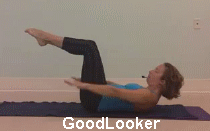
2. Twisting

3. Reverse crunches

4. Leg extension

5. Lowering the legs

6. Twisting to the side
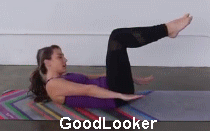
7. Trunk twists

8. One leg stretch

9. Straight leg stretch

10. Trunk twists

11. Heel touch

12. Twisting into a pleat

13. Raising arms and legs on all fours

14. Hyperextension

15. Raise the back with the spread of the arms
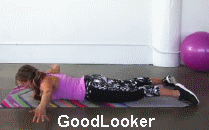
16. Swimming

1. Glute bridge

2. Raising the legs in the glute bridge

3. Raising the legs on all fours

4. Rhombic leg raise
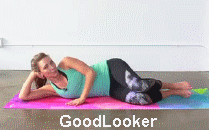
Or this option:
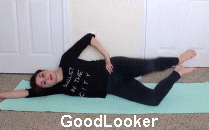
5. Side leg raise

Or this option:

6. Leg raise for the inner thigh

7. Kneeling Leg Raise

Pilates exercises for the upper body:
1. Plank

2. Plank leg raises

3. Mermaid

4. Turns to the side in the plank

5. Reverse plank

6. Knee push-ups + Leg raises

30 Advanced Pilates Exercises
Pilates exercises for the abdomen and back
1. "Hundred" with straightened legs

2. Double leg extension

3. Double straight leg stretch

4. Full twist

5. Trunk lift

6. Rolling on the back

7. Boat

8. Turns of the body in the position of the boat

9. Bicycle

10. Scissors
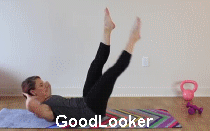
11. Leg rotation

12. Side fold

13. Cross Leg Raise

14. Superman

15. Advanced swimming option

Pilates exercises for legs and buttocks
1. Glute bridge on one leg

2. Gluteal bridge with leg rotation

3. Bridge on toes
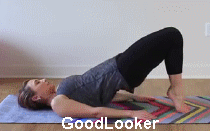
4. Rotation of the leg on all fours

5. Side leg swings

6. Closing the legs on the side

7. Circular movements of the leg on the back

8. Leg raises lying on the stomach

9. Side Leg Raise

Pilates upper body exercises
1. Classic push-up

2. Downward facing dog + push up

3. Knee touching elbow in plank

4. Side plank leg raises

5. Side plank crunches

6. Torso twists in the side plank

7. Pulsating plank leg raises

Thank you youtube channels for the gifs: The Live Fit Girl, Kathryn Morgan, FitnessType, Linda Wooldridge.
Just starting out with Pilates? Then we offer you a ready-made lesson plan with a basic set of simple Pilates exercises. If any exercise is not working for you or causes discomfort, skip it or modify it to an easier version.
- A hundred : 30 times
- Twisting: 15 times
- Lowering the legs : 15 times on each leg
- One leg stretch : 10 times on each leg
- Raising the back with dilution of the arms: 10 times
- Swimming
- Raising arms and legs on all fours : 10 times on each side
- Glute bridge: 15 times
- Quadruple Leg Raise : 15 times on each leg
- Diamond leg raise : 15 times on each leg
- Side leg raise : 10 times on each leg
- Leg raises for the inner thigh : 10 times on each leg
- Plank: 30 seconds
- Mermaid : 10 times on each side
- Reverse plank : 10 times on each leg

On average, this workout will take you about 20 minutes. Exercises can be swapped, but this is the most traditional arrangement of exercises in Pilates.
